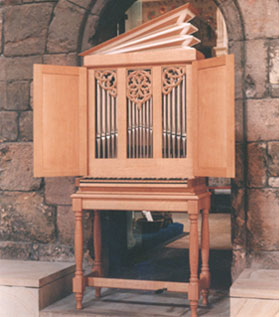
Lammermuir "Flatpack"
Chamber organs and house organs have had a significant place in organbuilding in Britain since before the seventeenth century. Because of their compact dimensions, such instruments often show great ingenuity of design, being musical instruments within furniture-quality cabinets.
Our instrument resembles the organ formerly at Hunstanton Hall, Norfolk (and now in Smithfield, Virginia, USA), which is undated and unsigned, bearing a close similarity to another chamber organ (currently owned by N P Mander) dated 1643 and signed “Christianus Smith”. In his book ‘The History of the English Organ’ Stephen Bicknell comments: “At a time when all the seventeenth century chamber organs were assumed to be by Father Smith it was naturally assumed that Christianus Smith was a relative, and this was in turn used to cement the theory that Bernard Smith came from an English family. It must now be admitted that there is no evidence to support this point, and for the time being Christianus Smith remains an isolated figure.” The Hunstanton organ is typical of instruments of the early seventeenth century.
Like the Hunstanton instrument, our 4’ kit organ has traditional morticed and tenoned frames around fielded panels in quartered white oak with doors over the facade display pipes and attractive moulding details. A wedge bellows with a small feeder bellows is in the top of the case. The stand and stool have attractive turned legs with a simple metal foot pedal, mounted in the stretcher frame, to operate the feeder bellows.
The single 4’ flute stop has pine and oak internal pipes with a traditional English style of construction. The facade pipes are supplied in low tin content metal. The pipeshades are supplied either as hand-carved pierced tracery or as blanks for fretted panels, both in solid oak.
The keyboard of 51 notes (C to d”’) is finished with boxwood naturals and ebony sharps on selected pine underkeys. The keyslips are moulded and match the casework materials. The key bed of morticed oak frames also serves as a structural part of the casework. The soundboard is of traditional construction and made with the grid, the well and the toeboard all of oak and pine. The traditional pine pallets are faced with felt and leather and are hinged at their tails directly onto the bars. The pullwires double as guide-pins and are directly linked through the keyboard forming an effective yet simple playing action, easily adjustable for levelling and depth of touch by leather buttons under the keyboard.
While our inspiration can rightly come from historical organs, contemporary instruments have to suit contemporary demands. With this in mind, a second kit can also be purchased as a lower case section (in place of the stand which can be easily be turned into an elegant side table). The lower case houses a second keyboard which can be coupled to the upper keyboard by means of a simple ‘shove’ coupler. It controls a full compass 8’ Stopped Diapason (permanently on) and a wooden 2’ Fifteenth drawn into play by means of a lever.
A 30-note parallel flat pedalboard is permanently coupled to the lower keyboard.
The complete instrument requires an electric blower motor, mounted in a separate sound-proofed box, regulated by the bellows in the upper case. This does not, however, affect the integrity of the foot-blowing facility as the upper case instrument can be lifted off and used as a separate instrument.
Apart from the satisfaction of partly building your own instrument following the detailed instruction manual supplied with the kit, the most obvious benefit will be in the financial outlay. Organbuilding uses quality materials and these kits do not compromise standards, but the labour charges involved in hand-finishing will be saved. We hope that musicians with a limited budget will thus be able to afford a genuine musical instrument, designed with integrity.
Please note - the 'flatpack" is no longer in production.